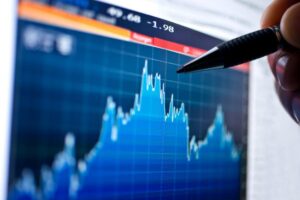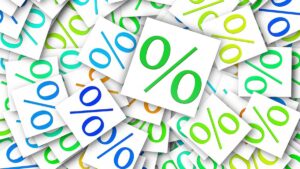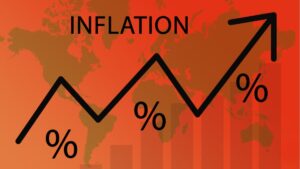
Stock indices of the largest countries of Western Europe in the course of trading on Wednesday show a positive mood on the data on weakening inflation in the UK and the eurozone.
The composite index of the largest European companies Stoxx Europe 600 increased by 0.4% to 462.45 points by 12:02 Q2.
German indicator DAX from the market opening rose by 0.2%, French CAC 40 – by 0.6%, British FTSE 100 – by 1.5% (to the maximum for a month). Italian FTSE MIB and Spanish IBEX 35 added 0.15% each.
Consumer prices in the UK in June rose by 7.9% in annualized terms – this is the minimum rise since March 2022. Inflation thus slowed from 8.7% in May.
The consensus forecast cited by Trading Economics had called for inflation to weaken to 8.2% in June.
Consumer price growth in Britain in monthly terms slowed to 0.1% in June from 0.7% in May. Analysts had expected an increase of 0.4%.
Consumer prices in the euro zone rose at a 5.5% annualized rate in June, according to final data. This is the weakest rise since January last year. Inflation was 6.1% in May.
The June figure matched both the preliminary estimate and the average forecast of experts.
Dutch manufacturer of chip equipment ASML Holding NV reduced net profit by 1% in the second quarter, but improved its revenue growth forecast for the current year. Quotes of the company’s shares are up 0.5%.
The price of securities Kering SA soared by almost 6%. The French holding company, which owns famous fashion brands, announced the departure of Gucci CEO Marco Bizzarri, who held the post since 2015. The brand will be led on an interim basis by group managing director Jean-François Palus.
Swedish access control systems maker Assa Abloy increased its second-quarter net profit by 13.3% to 3.57 billion kronor ($349 million) and revenue by 17% to 34.47 billion kronor. Analysts polled by FactSet had on average forecast 4.13 billion crowns and 33.68 billion crowns, respectively. The company’s shares are up 0.2%.
Stock prices of oil producers are also rising: BP Plc and Shell – by 1.1%, TotalEnergies – by 0.5%.
Meanwhile, the value of Volvo is down 1.7%. The Swedish truck maker reported a 5% rise in deliveries in the April-June quarter, but new orders fell 10%.
Antofagasta shares are down 1.1%. The company increased copper production by 2.5% in the second quarter relative to January-March to 149.6 thousand tons. However, the forecast for the whole current year was lowered to 640-670 thousand tons from previously expected 670-710 thousand tons.

Consumer price growth in Ukraine in May 2023 accelerated to 0.5% from 0.2% in April after slowing down from 1.5% in March, 0.7% in February and 0.8% in January, the State Statistics Service reported on Friday.
At the same time, inflation of 2.7% was recorded in May 2022, therefore, year-over-year in May 2023, it decreased to 15.3% from 17.9% in April, 21.3% in March, 24.9% in February and 26.6% in December.
Underlying inflation fell to 0.3% last month from 0.5% in April and 1.3% in March, the State Statistics Service said. Taking into account the fact that in May last year, underlying inflation was 1.4%, year-over-year it also fell to 15.9% in May from 17.2% in April, 20.1% in March and 22 .7% in February.
Since the beginning of the year, inflation in the country reached 3.8%, and underlying inflation was 3.3%, the State Statistics Service said.
In the consumer market in May, prices for food and non-alcoholic beverages rose by 0.9%. Most of all (by 8.7% and 5.6%) the prices of fruits and vegetables rose. Prices for meat and meat products, non-alcoholic drinks, fish and fish products, cheeses, butter grew by 1.7-0.2%. At the same time, prices for eggs fell by 22.7%, prices for processed grain products, lard, rice, sunflower oil, sugar, pasta, and milk dropped by 3.2–0.2%.
Prices for alcoholic beverages and tobacco products rose by 1.2%, including for tobacco products by 1.3%, and alcoholic beverages by 1.2%.
Clothing and footwear fell in price by 1.6%, in particular footwear by 1.9%, and clothing by 1.4%.
The 0.8% increase in prices in the healthcare sector was primarily due to a 1.0% increase in the cost of pharmaceutical products.
Transportation prices fell by 1.1% mainly due to a 2.5% reduction in the cost of fuel and lubricants.
As reported, in April, the National Bank of Ukraine improved its inflation forecast for this year from 18.7% to 14.8%, including in the second quarter, the NBU expected it to decline to 14.5%.

Consumer price growth in Ukraine slowed to 0.7% in February 2023 from 0.8% in January, returning to the level of December last year, the State Statistics Service (Gosstat) said on Friday. According to its data, 1.6% inflation was recorded in February-2022, so in annual terms in February-2023 it fell to 24.9% from 26% in January and from 26.6% in December last year.
Core inflation in the past month fell to 0.5% from 0.7% in January and 0.8% in December 2022, the Gosstat said.
With core inflation at 1% in February 2022, year-over-year core inflation also fell to 22.7% in January from 23.3%, just above last year’s 22.6%.
In the consumer market in February, prices for food and non-alcoholic beverages have increased by 1.5%. Vegetables went up most of all (by 13.9%). Fruit, poultry, fish and fish products, bread, milk and dairy products, pasta and soft drinks rose by 1.4-0.4%. At the same time, processed cereal products, eggs, rice, bacon, beef, pork and sunflower oil went down in price by 2.3-0.4%.
The prices of alcoholic beverages and tobacco products rose by 1.1%, including tobacco products – by 1.4% and alcoholic beverages – by 0.9%.
Clothing and footwear fell in price by 3.2%, including clothing by 3.2% and footwear by 3.1%.
An increase in prices in the health sector by 0.8% was primarily due to a 1.6% increase in the cost of outpatient services and hospital services.
Transport prices fell by 1.7% due to the decline in fuel and lubricants by 5.3%, as well as train fares by 1.5%.
As it was reported in January, the National Bank of Ukraine improved its inflation forecast for this year from 20.8% to 18.7%, including down to 23.6% in the first quarter and to 18.7% in the first half of the year.
The government this week also reported that its inflation forecast for the current year has been lowered to 24% from 28%.

The National Bank of Ukraine (NBU) has improved its inflation forecast for 2023 to 18.7% (the October forecast was 20.8%), as the market expected, the regulator’s press service said Thursday.
“The NBU forecasts a slowdown in inflation to 18.7% in 2023. This will be facilitated by continued tight monetary conditions, lower global inflation and weaker consumer demand amid power outages,” the statement explained.
It is pointed out that the receipt of announced volumes of international aid and joint actions of the NBU and the government on boosting the market of domestic debt attracting will allow to avoid emission financing of the budget deficit and to balance the currency market.
The regulator expects that inflation will slow down more quickly in the years to come due to lower security risks, a full recovery in logistics and an increase in yields.
The NBU, in particular, predicts that it will fall to 10.4 percent in 2024 and 6.7 percent in 2025.
“The main contribution to inflation in these years will have an administrative component due to the need to bring tariffs for housing and communal services to market levels,” the central bank explained.
It is noted that over the past three months the annual inflation rate has remained almost unchanged.
Stabilization of inflationary pressure was facilitated by the de-occupation of territories, the expansion of food supply, measures taken by the NBU and weaker consumer demand amid Russia’s energy terror.
At the same time, price pressures remain significant due to the aftermath of the war, including the destruction of enterprises and infrastructure and disruption of production and supply chains. Inflation expectations remained elevated despite stabilization.

Consumer price growth in Ukraine in December 2022 remained at the level of November – 0.7%, compared to 2.5% in October, 1.9% – in September and 1.1% – in August, returning to the level of July, the State Statistics Service (Gosstat) said on Tuesday.
Last December, there was a 0.6% inflation rate, so in annual terms it was 26.6% for the year as a whole, compared to 26.5% in November.
Core inflation fell to 0.8% last month from 1.3% in November and 1.9% in October, 2.4% in September and 2.1% in August.
Overall for the year, core inflation was 22.6%, the Gosstat said.
In mid-October, the National Bank kept the inflation forecast for 2022 at 30%, while the government improved it from 30.1% to 29.3% in late October.
The prices of food and non-alcoholic beverages in the consumer market rose by 0.7% in December. Oil, milk and dairy products, bread, fruit, vegetables, soft drinks, fish and fish products rose by 2.5-0.9%. At the same time, processed cereal products, eggs, sugar, poultry, bacon, pork and rice went down in price by 2.7-0.1%.
Prices for alcoholic beverages and tobacco products increased by 0.7%, which is associated with an increase in the price of tobacco products by 1.7%.
Clothing and footwear became cheaper by 2.6%, including clothing by 3.0% and footwear by 2.4%.
A 0.9% increase in health care prices was primarily due to a 1.3% increase in the price of outpatient services and a 1.0% increase in the price of pharmaceutical products.
Transportation prices rose 1.6% primarily due to a 3.1% increase in the price of fuel and lubricating oils.
As reported, Ukraine’s inflation rate in 2021 rose to 10% from 5% in 2020 and 4.1% in 2019, and the base rate rose to 7.9% from 4.5% a year earlier.

The growth of consumer prices in Ukraine in October 2022 accelerated to 2.5% from 1.9% in September, 1.1% in August and 0.7% in July, the State Statistics Service (Gosstat) reported on Thursday.
In October last year, inflation of 0.9% was recorded, so in annual terms, in October this year, it rose to 26.6% from 24.6% in September, 23.8% in August, 22.2% – according to the results of July and 21.5% – according to the results of June.
Core inflation fell to 1.9% last month from 2.4% in September and 2.1% in August.
Since the beginning of this year, over ten months, consumer prices in Ukraine have increased by 24.8%, while core inflation was 20.1%, the State Statistics Service said.
In mid-October, the National Bank kept its inflation forecast for 2022 at 30%, while the government improved it from 30.1% to 29.3% at the end of October.
In the consumer market in October, prices for food and non-alcoholic beverages rose by 4.2%. Most of all (by 60.5%) eggs have risen in price. Prices for lard, vegetables, fruits, meat and meat products, soft drinks, fish and fish products, cheeses, butter, and milk increased by 11.3-2.3%. At the same time, grain processing products fell in price by 4.8%.
Prices for alcoholic beverages and tobacco products increased by 0.9%, incl. for tobacco products – by 1%, alcoholic beverages – by 0.8%.
Clothing and footwear rose in price by 1.9%, including footwear – by 2.1%, clothing – by 1.7%.
The 1.2% increase in prices in the healthcare sector was primarily due to the increase in the cost of hospital services by 1.8% and outpatient services – by 1.6%.
Transportation prices rose by 0.8%, mainly due to a 1.5% increase in vehicle prices. At the same time, fares in railway passenger transport fell by 5.1%.
As reported, in 2021 inflation in Ukraine rose to 10% from 5% in 2020 and 4.1% in 2019, while core inflation rose to 7.9% against 4.5% a year earlier.